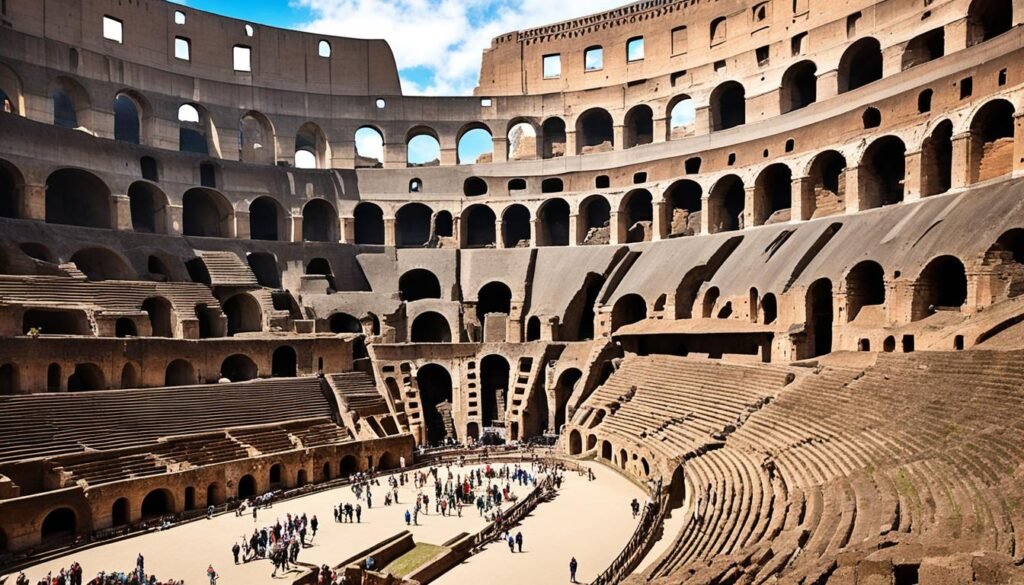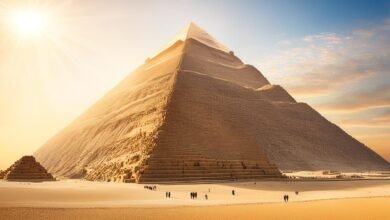Table of Contents
Imagine standing in ancient Rome’s heart, looking up at a grand structure that has stood the test of time. The Colosseum in Rome is a tribute to the greatness of an ancient civilization. Visiting this landmark fills you with awe.
The Colosseum has captured the imagination of travelers for centuries. Its impressive size and history make it a top sight in Rome. It’s a special place for everyone, whether you love history, architecture, or connecting with the past.
Walk in the steps of ancient gladiators and explore the tunnels they used. Let your imagination take you to a time when crowds cheered in its halls. Feel the spirit of ancient Rome come to life around you.
Seeing the Colosseum is an experience you won’t forget. It’s full of amazing sights and a strong sense of history. Get ready for a journey back in time to see the grandeur of one of the New Seven Wonders of the World.
Plan Your Visit to the Colosseum
Planning ahead is key to enjoying the Colosseum. Here’s information to help you get around smoothly.
Colosseum Tickets
Tickets for the Colosseum are a hot item, especially in busy seasons. To avoid missing out, book in advance. Sites like Ticketmaster and GetYourGuide make it easy to buy tickets early. This way, you can skip the long lines and pick when you enter.
Colosseum Opening Times
The Colosseum’s open hours change throughout the year. Always check the official website or call ahead to confirm. Knowing the hours will help plan your day and fully enjoy this historic site.
Transport to the Colosseum
Getting to the Colosseum by Rome’s public transport is easy. You can take the subway, bus, or tram. The Colosseo subway station on Line B is near the Colosseum. Buses 75 and 85 also stop close by. Or, consider renting a bike for a fun way to see the city.
Choose any travel option, but allow extra time for delays. This way, you arrive relaxed and ready to explore.
| Transport Option | Journey Time |
|---|---|
| Subway (Line B, Colosseo station) | Approximately 10 minutes from Termini Station |
| Bus Lines 75 and 85 | Approximately 15-20 minutes from Rome city center |
| Tramway | Various routes available with approximate journey times depending on your starting point |
Colosseum Architecture and Design
The Colosseum in Rome is famous for its stunning architecture and design. This ancient amphitheater is a symbol of Roman engineering and building skills.
Its unique elliptical shape made it the biggest of its time. The Colosseum could hold up to 60,000 people. Its size and design still amaze us today.
The Colosseum’s entrances have beautiful details that show the luxury of ancient Rome. Inside, there are tunnels, stairs, and corridors. These were smartly made for easy movement of people, gladiators, and animals during events.
It was made mostly from travertine stone and concrete. The Colosseum shows off ancient Rome’s excellent craftsmanship. The travertine exterior, with its detailed columns, shows its elegance and grandeur. The materials chosen made it strong and beautiful.
The Colosseum’s design cared about looks as well as function. It features Doric, Ionic, and Corinthian columns. These add classical beauty to its appearance. This mix of styles makes the Colosseum eternally beautiful.
“The Colosseum is a testament to the ingenuity and architectural prowess of the ancient Romans. Its design and construction remain a marvel to this day, captivating visitors from around the world.”
Must-See Features of the Colosseum
When you visit the Colosseum, don’t miss its key features. The underground area, or Colosseum hypogeum, is where gladiators and animals waited their turn. This area was packed with tunnels and rooms for smooth movement. The Colosseum arena is where the real action happened.
Standing where gladiators once fought is an incredible experience. It lets you feel the history beneath your feet.

The underground of the Colosseum, the Colosseum hypogeum, showed ancient Rome’s clever engineering. It had lifts, ramps, and trapdoors for moving gladiators and animals. This maze showcased the creativity of Roman architects and engineers, creating unforgettable spectacles.
Seeing the Colosseum’s underground and arena is fascinating. It shows the grandeur and ingenuity of ancient theater. You’ll see the hard work behind the historical shows. Make sure to see the amazing Colosseum hypogeum and Colosseum arena.
| Must-See Features | Description |
|---|---|
| Colosseum Hypogeum | The underground area where gladiators and animals were kept before their performances. |
| Colosseum Arena | The main stage where gladiatorial games and other events took place. |
Surrounding Monuments and Attractions
The Colosseum is an ancient Roman wonder in the heart of Rome. The area’s beauty doesn’t stop with the Colosseum. Nearby, famous monuments and attractions add to the region’s historic and cultural charm.
Arch of Constantine
Near the Colosseum, the Arch of Constantine stands tall. This arch honors Emperor Constantine’s victory. It shows the Roman Empire’s strength. The arch’s detailed carvings take you back to ancient days.
Domus Aurea
Close to the Colosseum are the Domus Aurea ruins, Emperor Nero’s lavish palace. Through guided tours, discover its once luxurious essence. You’ll see old frescoes and vast gardens. The Domus Aurea reveals Rome’s rich history and architecture.
Roman Circus
The Roman Circus, or Circus Maximus, is a must for fans of ancient sports. It was famous for chariot races. Walking its large oval, you feel the excitement of past events.
Palatine Hill and Roman Forum
Palatine Hill overlooks the Colosseum. Here, explore gardens and ancient sites to learn about the Roman Empire. Enjoy stunning views of the Colosseum and Rome.
Next to Palatine Hill lies the Roman Forum, Rome’s ancient center. Wander among temple ruins and public squares. It feels like stepping into Rome’s bustling past. The Forum showcases Rome’s architectural and cultural wonders.
Rome’s monuments and attractions near the Colosseum are captivating. From the Arch of Constantine to Palatine Hill and the Roman Forum, each place has its own story. Exploring these sites makes your Colosseum trip a memorable journey through ancient Rome.
Tips for Visiting the Colosseum
Planning your trip to the Colosseum needs some prep for a great time. Think about security checks and how long you’ll wait. Here are important things to keep in mind:
Colosseum Security
The Colosseum takes safety seriously to protect all who visit. It’s best to leave big bags and backpacks at home. Smaller bags are better and speed up the entry process. This makes the visit better for everyone.
Colosseum Waiting Times
The Colosseum gets really busy, especially during tourist season. To beat the queues, try getting there early in the morning. This can help you avoid long waits and crowds. A well-planned visit lets you enjoy more and stress less.
Colosseum Dress Code
There’s no special dress code for the Colosseum. But, comfy clothes and shoes are key because there are a lot of stairs. Also, check the weather for your visit so you can stay comfortable all day.
Colosseum Parking
It’s smarter to use public transportation when visiting the Colosseum. Rome’s buses, subways, and trams make it easy to get there. This way, you won’t have to worry about parking or traffic. Going by public transport saves time and stress.
To enjoy your Colosseum visit, think about your comfort and plan ahead. Remember the safety rules. This way, you’ll get to truly experience the beauty and history of this amazing place.
Accessibility at the Colosseum
The Colosseum welcomes everyone, including those with disabilities. Its design now includes features to make sure everyone enjoys their visit. This ancient marvel is for everyone to explore.
Entrance for All
Colosseum accessibility starts at the entrance. There are no stairs at the main entrance. This makes it easy for those in wheelchairs or with walking problems to get in. Everyone can access the amazing ruins easily.
Elevator to the Upper Floor
An elevator is available for those who find stairs hard. This allows everyone to see the different levels and enjoy the views.
However, some parts have ancient cobblestones and are not flat. If you have trouble moving around, you might need to plan carefully and be cautious.
Special Considerations
Before you visit, it’s good to check what accessibility features the Colosseum offers. This helps make sure you have a great time.
Colosseum accessibility is about including everyone. It lets all visitors dive into its deep history and beauty.

| Accessibility Features | Details |
|---|---|
| Main Entrance | Free of stairs for easy access |
| Elevator | Provides access to the upper floor |
| Cobblestone Areas | Some areas may not be completely flat |
Best Time to Visit the Colosseum
Planning to see the Colosseum? You’ll want to pick the perfect time. This helps you dodge the crowds and enjoy your visit more. The right timing lets you experience the ancient monument’s beauty calmly.
Morning Bliss
Early morning, right after opening, is the ideal time to visit. It beats the crowds and lets you explore easily. Morning’s soft light and calm add a magical touch, making your time there unforgettable.
In the early hours, the Colosseum isn’t packed. This means you can take great photos and dive deep into its rich history. You can feel the echo of past cheers and claps as you walk around.
Weekdays see fewer visitors than weekends. To have a more personal and calm experience, aim for a weekday trip.
A Night to Remember
Consider a night tour of the Colosseum for a special experience. When night falls, it reveals a new, stunning side. With fewer people and gentle lighting, it feels even more majestic.
Night tours highlight the Colosseum’s grandeur with dramatic lighting. This setting sends you back in time, filling you with wonder.
However, night tours might not cover nearby attractions like the Roman Forum and Palatine Hill. For those sites, daytime visits are better. Choosing between morning or night depends on what you like and when you’re free. Either way, the Colosseum’s history and beauty will amaze you.
Plan well to fully enjoy your visit to this ancient Rome icon.
Colosseum History and Significance
The Colosseum is rich in history and important to Roman culture. Built in the 1st century AD, it was a gift from Emperor Vespasian of the Flavian dynasty. It shows the architectural skill of ancient Rome.
It was first called the Flavian Amphitheatre. The Colosseum was a place for events like gladiator fights and animal hunts. These events entertained people and showed the power of the Roman Empire.
Building the Colosseum was an amazing feat. It could hold over 50,000 people, making it the biggest amphitheater in the world. It showed off Roman architecture and creativity.
“The structure that inspired awe not only displayed the wealth and might of the empire, but also became a symbol of social order‚ commemorating Rome and its heritage”
Over time, the Colosseum faced damages from earthquakes and theft. Yet, its importance led to efforts to restore and preserve it. This helps keep it a treasured monument and a symbol of ancient Rome.
The Colosseum still enchants visitors from everywhere. It gives us a look at the past and reminds us of Roman ingenuity and splendor.
Colosseum Architecture and Design
The Colosseum, also called the Flavian Amphitheatre, is a wonder of ancient Roman work. Its design shows just how skilled ancient Romans were at building. It’s also known for its huge size, making it a world-famous structure.
Massive Structure
The Colosseum is huge. It’s 189 meters long, 156 meters wide, and 50 meters high. It holds the Guinness World Record as the largest amphitheater.
Intricate Architectural Details
The Colosseum’s design is full of stunning details. It has exterior columns and arches in Doric, Ionic, and Corinthian styles. These features make the Colosseum uniquely beautiful.
“The Colosseum, a testament to the architectural brilliance of ancient Rome.”
Retractable Awning for Spectators
The Colosseum had a velarium, or retractable awning, to shade spectators. This awning was adjusted based on the weather, keeping the audience comfortable.
Impressive Seating Capacity
The Colosseum could seat over 50,000 people. It was built with many entrances and a smart seating plan. This made crowd movement smooth and viewing comfortable for everyone.
The Colosseum’s architecture is still admired today. It remains a must-see for those wanting to feel the greatness of Ancient Rome.
Colosseum Entrances and Accessibility
When you visit the Colosseum, you’ll notice it has many entrances, each with a number. This makes finding your seat a breeze. These entries were not just placed randomly. Some were only for VIPs like emperors and senators.
The Sperone Valadier entrance, which looks out over the forums, is now the main entry for individual visitors. It gives easy access to the main parts of the Colosseum.
Are you here for a guided tour to see the arena? Then, you will go through the Stern entrance. This special entrance takes you right to the arena floor. Imagine standing where gladiators fought for their lives!
The Colosseum is also set up for visitors with disabilities. Special entrances and facilities are there to make sure everyone has a great visit. The main entry is wheelchair friendly, with an elevator to take you to the upper levels. But, remember, the old cobblestones might make some spots a bit tricky. So, it’s a good idea to look into specific access options beforehand.
| Colosseum Entrances | Accessibility |
|---|---|
| Sperone Valadier | Wheelchair accessible |
| Stern | Guided tours with access to the arena |
| Designated entrances for visitors with disabilities | Facilities and elevator to the upper floor |
The Colosseum at Night
Seeing the Colosseum in Rome at night is breathtaking. A night visit shows you this old wonder in a new light. It’s truly unforgettable.
At night, the Colosseum is less crowded. This means you can enjoy it more, taking your time to see its beauty. You get to experience it in a special way.
The Colosseum lights up beautifully at night. Walking through, you’ll feel its historic magic. The quiet of the night makes it even more stunning, letting you fully enjoy its ancient charm.
There’s more fun nearby after your tour. You can check out vibrant night markets and try tasty local foods. It’s a great way to dive into the city’s culture and enjoy the evening.




